Макиавелли Николай. Государь (Il Principe) и Рассуждения на первые три книги Тита Ливия. Пер. c итал. Н. Курочкина. Издание "Русской книжной торговли". - СПб.; тип. Тиблена и Ко. (Неклюдова), 1869. - 502 стр.
-

-
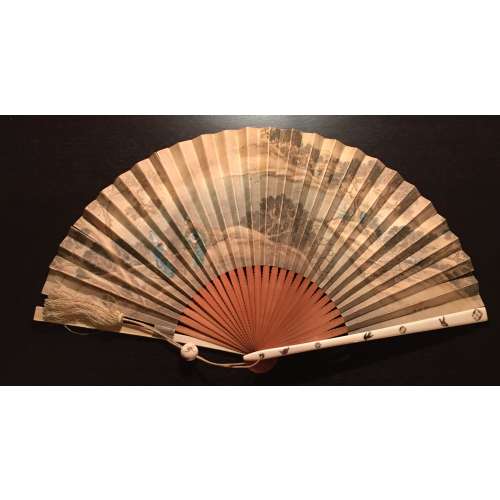 Late 19th-century (1850-1870) Japanese export fan. This fan has a double leaf painted with a different design on either side. Ivory encrusted with gemstones (birds and shippomon motif). Painting by ukiyo-e artist and printmaker Katsushika Isai (1821–1880) represents a riverside landscape with figures; birds and flowers on the reverse. Signed: Isai ga (為斎画) - "Painted by Isai".
Late 19th-century (1850-1870) Japanese export fan. This fan has a double leaf painted with a different design on either side. Ivory encrusted with gemstones (birds and shippomon motif). Painting by ukiyo-e artist and printmaker Katsushika Isai (1821–1880) represents a riverside landscape with figures; birds and flowers on the reverse. Signed: Isai ga (為斎画) - "Painted by Isai". -
 Artist: Utagawa Kuniyoshi [歌川 國芳] (Japanese, 1798 – 1861).
Artist: Utagawa Kuniyoshi [歌川 國芳] (Japanese, 1798 – 1861).Title: Suzume fukube [美人団扇絵] (Sparrow and gourds).
Series: Kacho awase [花鳥合] (Collection of flowers and birds).
Publisher: Aritaya Seiemon [有田屋 清右衛門] (Japanese, fl. c. 1830 – 1862); Seal: Marks 17-011 | 014d.Signed: Ichiyosai Kuniyoshi ga in a red cartouche and sealed with paulownia crest (kiri mon).
Size: Uchiwa-e (untrimmed fan print) 296 x 230 mm.
Double nanushi censor seals: Kinugasa & Watanabe, Kaei 2-3 (1849–50).
Ref.: Kuniyoshi Project. -
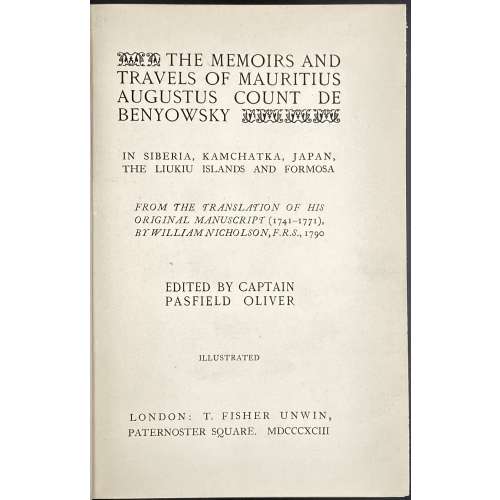 Hardcover volume in 8vo, 21.2 x 15.4 cm, tan cloth with black on gilt background circular publisher’s device "TFU" to front cover, gilt-stamped compartments and burgundy labels with gilt lettering to spine. Ink inscription to fep verso dated Jan 18, 1907. Publisher's device and serial device to h.t. Title-page: ❦❦❦ THE MEMOIRS AND | TRAVELS OF MAURITIUS AUGUSTUS COUNT DE | BENYOWSKY | IN SIBERIA, KAMCHATKA, JAPAN, THE LIUKIU ISLANDS AND FORMOSA | FROM THE TRANSLATION OF HIS | ORIGINAL MANUSCRIPT (1741–1771), | BY WILLIAM NICHOLSON, F.R.S., 1790 | EDITED BY CAPTAIN | PASFIELD OLIVER | ILLUSTRATED | LONDON: T. FISHER UNWIN, | PATERNOSTER SQUARE. MDCCCXCIII ❦❦❦ ||. Collation/Pagination: [1]-258 plus 7 plates, incl. frontispiece and 1 map. [1, 2] – serial h.t. "The Adventure Series" / advert. THE ADVENTURE SERIES. Illustrated. Crown 8vo, 5s. 17 titles, [3, 4] – t.p. / blank, [5] 6-9 contents, [10] blank, [11, 12] illustrations/blank, [13] 14-52 introduction, 53-399, [400] colophon: THE GRESHAM PRESS, | URWIN BROTHERS, | CHILWORTH AND LONDON. Contributors: Publisher: T. Fisher Unwin (London); Thomas Fisher Unwin (British, 1848 – 1935). Author: Maurice Auguste count de Benyowsky [Мориц Август Бенёвский] (Polish-Slovak-Hungarian, 1746 –1786). Editor: Samuel Pasfield Oliver (British, 1838 – 1907). Translator: William Nicholson (British, 1753 – 1815). Originally published in 1790, in London (I have not seen it anywhere) and in Dublin by P. Wogan [etc.], and in 1791 in French, in Paris by Buisson; see LIB-2742.2021. For another copy of the same edition, see LIB-3139.2023. For the 1904 edition, see LIB-2703.2021.
Hardcover volume in 8vo, 21.2 x 15.4 cm, tan cloth with black on gilt background circular publisher’s device "TFU" to front cover, gilt-stamped compartments and burgundy labels with gilt lettering to spine. Ink inscription to fep verso dated Jan 18, 1907. Publisher's device and serial device to h.t. Title-page: ❦❦❦ THE MEMOIRS AND | TRAVELS OF MAURITIUS AUGUSTUS COUNT DE | BENYOWSKY | IN SIBERIA, KAMCHATKA, JAPAN, THE LIUKIU ISLANDS AND FORMOSA | FROM THE TRANSLATION OF HIS | ORIGINAL MANUSCRIPT (1741–1771), | BY WILLIAM NICHOLSON, F.R.S., 1790 | EDITED BY CAPTAIN | PASFIELD OLIVER | ILLUSTRATED | LONDON: T. FISHER UNWIN, | PATERNOSTER SQUARE. MDCCCXCIII ❦❦❦ ||. Collation/Pagination: [1]-258 plus 7 plates, incl. frontispiece and 1 map. [1, 2] – serial h.t. "The Adventure Series" / advert. THE ADVENTURE SERIES. Illustrated. Crown 8vo, 5s. 17 titles, [3, 4] – t.p. / blank, [5] 6-9 contents, [10] blank, [11, 12] illustrations/blank, [13] 14-52 introduction, 53-399, [400] colophon: THE GRESHAM PRESS, | URWIN BROTHERS, | CHILWORTH AND LONDON. Contributors: Publisher: T. Fisher Unwin (London); Thomas Fisher Unwin (British, 1848 – 1935). Author: Maurice Auguste count de Benyowsky [Мориц Август Бенёвский] (Polish-Slovak-Hungarian, 1746 –1786). Editor: Samuel Pasfield Oliver (British, 1838 – 1907). Translator: William Nicholson (British, 1753 – 1815). Originally published in 1790, in London (I have not seen it anywhere) and in Dublin by P. Wogan [etc.], and in 1791 in French, in Paris by Buisson; see LIB-2742.2021. For another copy of the same edition, see LIB-3139.2023. For the 1904 edition, see LIB-2703.2021. -
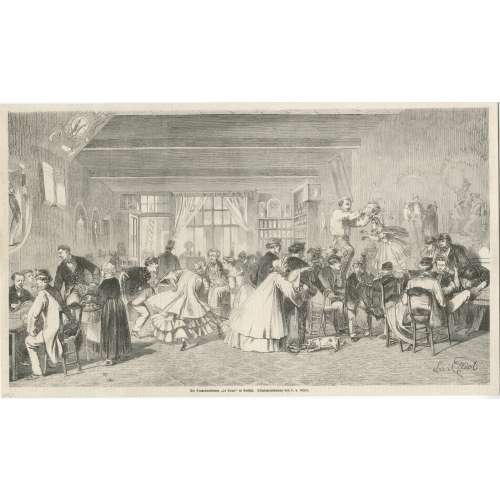
A woodcut illustration after drawing by Leo von Elliot, published at Illustrirte Zeitung, 17 January 1863. English translation: Student bar "The Hole" in Brussels.
The official name of this bar, located at Rue des Sols in Bussels, was "À la vue de l'Université" (In sight of the University). This was the place where the students of the Université libre de Bruxelles (Free University of Brussels), and especially the members of Société, ou Cercle, des Crocodiles (The Crocodile Society, or Circle), gathered in the 1860s. -
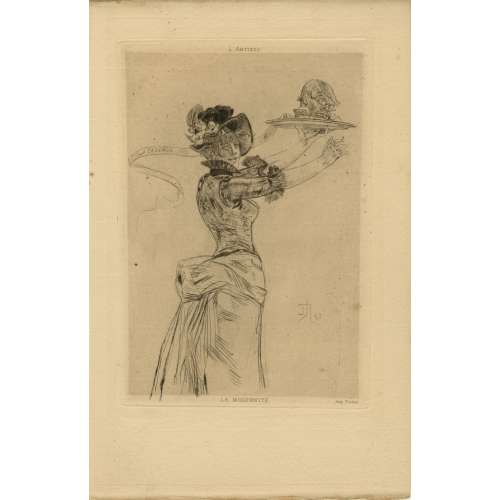
Drypoint on wove paper, depicting a woman in a hat with a ribbon lettered "ACADEMIE", carrying in her hand a male head in spectacles on a plate. Monogrammed "FR 83", inscribed: LA MODERNITÉ. — Imp. Eudes.; in pencil on verso."L'ARTISTE" – OCT. 1886 | (PRUD'HOMME ONTHOOFD) E 332-V". Owner's stamp 'LvM' on verso.
Dimensions: Paper: 27.2 x 17.8 cm; Plate: 19.7 x 14 cm; Image: 18.5 x 13 cm.
Catalogue raisonné: Rouir 767:5; Arthur Hubschmid (1977): 405; Graphics irreverent and erotic (1968): 72.
-
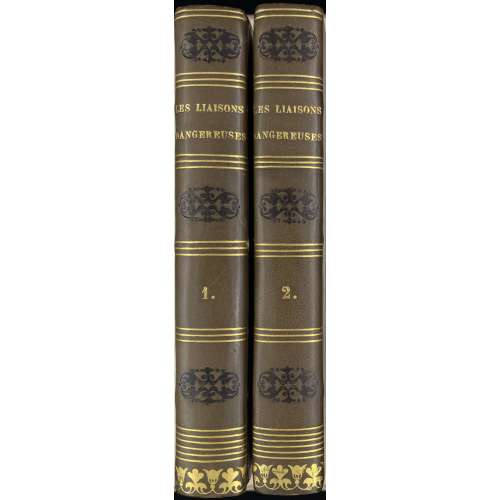 [Choderlos de Laclos.] Les Liaisons dangereuses, lettres recueillies dans une société, et publiées pour l’instruction de quelques autres; par M. C*** de L*** / Ornées de 6 gravures d'après Devéria. — Londres: s.n., 1820. Description: two volumes, collated 12mo, 17.1 x 10.6 cm each, modern binding – recently bound in quarter brown calf with gilt lettering, fillets and black fleurons to spine over green marbled boards; bookplate to front pastedown in each volume: “Ex-Libris | F.-M. Caye”. Printed on laid paper, each volume is illustrated with a frontispiece and two plates engraved by various engravers after Achille Devéria under the direction of Ambroise Tardieu. Title-page: LES LIAISONS | DANGEREUSES, | LETTRES RECUEILLIES | DANS UNE SOCIÉTÉ, | ET PUBLIÉES POUR L’INSTRUCTION DE QUELQUES AUTRES. | PAR M. C*** DE L***. | {3 lines of citation from J.-J. Rousseau} | TOME PREMIER (TOME SECOND) | — | A LONDRES. | ~ | M.D.CCC.XX. || Collation: Vol. 1: π8 1-1412 156, total 182 leaves plus 3 engraved plates: frontispiece and opposite to pp. 37 and 338. Pagination: [1-5] 6-16, [1] 2-348, total 364 pages. Vol. 2: π2 16 2-1512 162, total 178 leaves plus 3 engraved plates: frontispiece and opposite to pp. 25 and 316. Pagination: [4] [1] 2-352, total 356 pages. Provenance: Caye, F.-M. Pierre Ambroise François Choderlos de Laclos (French, 1741 – 1803) – author. Achille Jacques-Jean-Marie Devéria (French, 1800 – 1857) – artist. Engravers: Ambroise Tardieu (French, 1788 – 1841) Jean Baptiste Touzé (French, fl. 1810 – 1830) Jean Jacques Frilley (French, 1797 – after 1850) Achille Lefèvre (French, 1798 – 1864) Jean Louis Toussaint Caron (French, 1790 – 1832)
[Choderlos de Laclos.] Les Liaisons dangereuses, lettres recueillies dans une société, et publiées pour l’instruction de quelques autres; par M. C*** de L*** / Ornées de 6 gravures d'après Devéria. — Londres: s.n., 1820. Description: two volumes, collated 12mo, 17.1 x 10.6 cm each, modern binding – recently bound in quarter brown calf with gilt lettering, fillets and black fleurons to spine over green marbled boards; bookplate to front pastedown in each volume: “Ex-Libris | F.-M. Caye”. Printed on laid paper, each volume is illustrated with a frontispiece and two plates engraved by various engravers after Achille Devéria under the direction of Ambroise Tardieu. Title-page: LES LIAISONS | DANGEREUSES, | LETTRES RECUEILLIES | DANS UNE SOCIÉTÉ, | ET PUBLIÉES POUR L’INSTRUCTION DE QUELQUES AUTRES. | PAR M. C*** DE L***. | {3 lines of citation from J.-J. Rousseau} | TOME PREMIER (TOME SECOND) | — | A LONDRES. | ~ | M.D.CCC.XX. || Collation: Vol. 1: π8 1-1412 156, total 182 leaves plus 3 engraved plates: frontispiece and opposite to pp. 37 and 338. Pagination: [1-5] 6-16, [1] 2-348, total 364 pages. Vol. 2: π2 16 2-1512 162, total 178 leaves plus 3 engraved plates: frontispiece and opposite to pp. 25 and 316. Pagination: [4] [1] 2-352, total 356 pages. Provenance: Caye, F.-M. Pierre Ambroise François Choderlos de Laclos (French, 1741 – 1803) – author. Achille Jacques-Jean-Marie Devéria (French, 1800 – 1857) – artist. Engravers: Ambroise Tardieu (French, 1788 – 1841) Jean Baptiste Touzé (French, fl. 1810 – 1830) Jean Jacques Frilley (French, 1797 – after 1850) Achille Lefèvre (French, 1798 – 1864) Jean Louis Toussaint Caron (French, 1790 – 1832) -
 Artist: Utagawa Kunisada [歌川 国貞] a.k.a. Utagawa Toyokuni III [三代歌川豊国] (Japanese, 1786 – 1865). Signed: Kōchō(rō) Kunisada ga (香蝶国貞画) in a red double-gourd cartouche. Publisher: Surugaya Sakujirō [駿河屋作次郎] (Japanese, fl. c. 1844 – 1865); Marks 06-005 | 501a. Single nanushi censor seal: Muramatsu (1843-6). The date is attributed to c. 1844. Title: Narihira [なり平]. Ariwara no Narihira [在原 業平] (Japanese, 825 – 880) – one of the Six Immortal Poets – The Rokkasen [六歌仙]. Series: A parody of six immortal poets [見立六花撰] (Mitate Rokkasen). Media: Untrimmed fan print (uchiwa-e), 227 x 293 mm, depicting a beautiful woman with a bow and arrows in her left hand. Series: Mitate Rokkasen [見立六花撰] – is sometimes interpreted as "A parody of six immortal poets" or "A comparison of six select flowers". [LIB-1212.2017] Robert Schaap. Kunisada: Imaging, drama and beauty. — Leiden: Hotei Publishing, 2016; pl. 28, p. 58. This is another fan print with another immortal poet, Bun'ya no Yasuhide [文屋 康秀] (Japanese, -d. 885?), from the same series, provided in the book:With special thanks to Horst Graebner for help with the description and date attribution: "The print can be dated to 1844: censor seal is Muramatsu (Muramatsu Genroku); he acted in 7/1844 and 4/1845 (and also later) as censor but Kunisada changed his name to Kunisada early in 1844."
Artist: Utagawa Kunisada [歌川 国貞] a.k.a. Utagawa Toyokuni III [三代歌川豊国] (Japanese, 1786 – 1865). Signed: Kōchō(rō) Kunisada ga (香蝶国貞画) in a red double-gourd cartouche. Publisher: Surugaya Sakujirō [駿河屋作次郎] (Japanese, fl. c. 1844 – 1865); Marks 06-005 | 501a. Single nanushi censor seal: Muramatsu (1843-6). The date is attributed to c. 1844. Title: Narihira [なり平]. Ariwara no Narihira [在原 業平] (Japanese, 825 – 880) – one of the Six Immortal Poets – The Rokkasen [六歌仙]. Series: A parody of six immortal poets [見立六花撰] (Mitate Rokkasen). Media: Untrimmed fan print (uchiwa-e), 227 x 293 mm, depicting a beautiful woman with a bow and arrows in her left hand. Series: Mitate Rokkasen [見立六花撰] – is sometimes interpreted as "A parody of six immortal poets" or "A comparison of six select flowers". [LIB-1212.2017] Robert Schaap. Kunisada: Imaging, drama and beauty. — Leiden: Hotei Publishing, 2016; pl. 28, p. 58. This is another fan print with another immortal poet, Bun'ya no Yasuhide [文屋 康秀] (Japanese, -d. 885?), from the same series, provided in the book:With special thanks to Horst Graebner for help with the description and date attribution: "The print can be dated to 1844: censor seal is Muramatsu (Muramatsu Genroku); he acted in 7/1844 and 4/1845 (and also later) as censor but Kunisada changed his name to Kunisada early in 1844."
Robert Schaap, 2016.
-
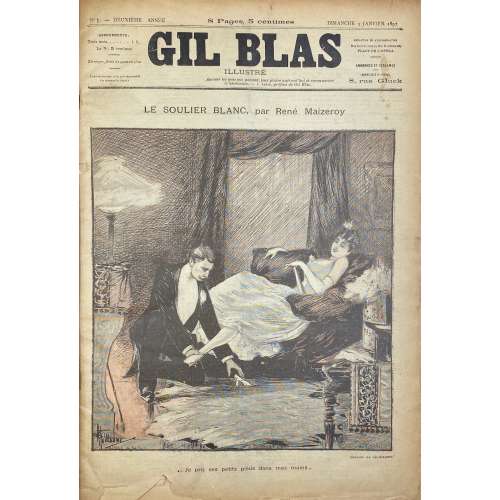 52 issues of French weekly Gil Blas illustré, 1892: №№ 1-52; published in Paris, 39 x 29 cm, bound in red half cloth over marbled boards, with gilt fillets and lettering to spine, marbled endpapers, profusely illustrated by Théophile Steinlen (Swiss-French, 1859 – 1923) and Albert Guillaume (French, 1873 – 1942).
52 issues of French weekly Gil Blas illustré, 1892: №№ 1-52; published in Paris, 39 x 29 cm, bound in red half cloth over marbled boards, with gilt fillets and lettering to spine, marbled endpapers, profusely illustrated by Théophile Steinlen (Swiss-French, 1859 – 1923) and Albert Guillaume (French, 1873 – 1942). -
 Artist: Utagawa Kuniyoshi [歌川 國芳] (1798 – 1861). Kabuki actors Ichikawa Danjūrō VIII and Arashi Rikan III as sumo wrestlers Nuregami Chōgorō (L) and Hanaregoma Chōkichi (R), respectively. Signed: Ichiyûsai Kuniyoshi ga (一勇斎 國芳 画) in a double gourd-shaped cartouche with Yoshi Kiri seal. Publisher: No seal. Date seal and double nanushi censor seal: Mera & Watanabe, 1852. Media: Fan print (uchiwa-e, 団扇絵), 231 x 295 mm. Theme: Nine-act drama (11 scenes) Futatsu Chōchō Kuruwa Nikki [双蝶々曲輪日記] (A Diary of Two Butterflies in the Pleasure Quarters) written by Takeda Izumo II, Namiki Senryū I, Miyoshi Shōraku (7/1749) as puppet play Bunraku [文楽], adopted for Kabuki theatre by Arashi San'emon IV. “The sumo wrestler Nuregami Chōgorō is trying to ransom the courtesan Azuma for Yogoro, in whose debt he stands. Hiraoka Goemon, who is at odds with Yogorō and Azuma, is the patron of the amateur wrestler Hanaregoma Chōkichi. Chōgorō purposely loses to Chōkichi and then asks the latter to stop Goemon's ransoming of Azuma; Chōkichi refuses, however, and they quarrel. Admonished for his dissipation by his sister Oseki, Chōkichi is going to commit ritual suicide (seppuku) as an apology for his behavior, but Chōgorō, who happens along just then, prevents him. The two men swear blood brotherhood. […] The confrontation between Chōgorō and Chōkichi in the Sumōba scene, acted in the exaggerated style called aragoto, is a major highlight of the work. The scene in Yohei's home, known as Hikimado, presents the unfolding of Kabuki's eternal conflict between duty and feelings, here represented by the act of opening the skylight (hikimado) to which Chōgorō is tied”. [Samuel L. Leiter. Kabuki Encyclopedia: an English-language adaptation of Kabuki Jiten. — Westport, CT; London: Greenwood Press, 1979, pp. 70-71]. See also James R. Brandon and Samuel L. Leiter. Kabuki plays on stage, vol. 1, pp. 234-258. — Honolulu: University of Hawai'i Press, 2002. Actors: Ichikawa Danjūrō VIII [市川団十郎] (Japanese, 1823 – 1854); other names: Ichikawa Ebizō VI, Ichikawa Shinnosuke II. Arashi Rikan III [嵐璃寛] (Japanese, 1812 – 1863); other names Arashi Tokusaburō III, Arashi Kicchō I, Onoe Wasaburō I. Another print in this collection with the same theme: SVJP-0331.2020.
Artist: Utagawa Kuniyoshi [歌川 國芳] (1798 – 1861). Kabuki actors Ichikawa Danjūrō VIII and Arashi Rikan III as sumo wrestlers Nuregami Chōgorō (L) and Hanaregoma Chōkichi (R), respectively. Signed: Ichiyûsai Kuniyoshi ga (一勇斎 國芳 画) in a double gourd-shaped cartouche with Yoshi Kiri seal. Publisher: No seal. Date seal and double nanushi censor seal: Mera & Watanabe, 1852. Media: Fan print (uchiwa-e, 団扇絵), 231 x 295 mm. Theme: Nine-act drama (11 scenes) Futatsu Chōchō Kuruwa Nikki [双蝶々曲輪日記] (A Diary of Two Butterflies in the Pleasure Quarters) written by Takeda Izumo II, Namiki Senryū I, Miyoshi Shōraku (7/1749) as puppet play Bunraku [文楽], adopted for Kabuki theatre by Arashi San'emon IV. “The sumo wrestler Nuregami Chōgorō is trying to ransom the courtesan Azuma for Yogoro, in whose debt he stands. Hiraoka Goemon, who is at odds with Yogorō and Azuma, is the patron of the amateur wrestler Hanaregoma Chōkichi. Chōgorō purposely loses to Chōkichi and then asks the latter to stop Goemon's ransoming of Azuma; Chōkichi refuses, however, and they quarrel. Admonished for his dissipation by his sister Oseki, Chōkichi is going to commit ritual suicide (seppuku) as an apology for his behavior, but Chōgorō, who happens along just then, prevents him. The two men swear blood brotherhood. […] The confrontation between Chōgorō and Chōkichi in the Sumōba scene, acted in the exaggerated style called aragoto, is a major highlight of the work. The scene in Yohei's home, known as Hikimado, presents the unfolding of Kabuki's eternal conflict between duty and feelings, here represented by the act of opening the skylight (hikimado) to which Chōgorō is tied”. [Samuel L. Leiter. Kabuki Encyclopedia: an English-language adaptation of Kabuki Jiten. — Westport, CT; London: Greenwood Press, 1979, pp. 70-71]. See also James R. Brandon and Samuel L. Leiter. Kabuki plays on stage, vol. 1, pp. 234-258. — Honolulu: University of Hawai'i Press, 2002. Actors: Ichikawa Danjūrō VIII [市川団十郎] (Japanese, 1823 – 1854); other names: Ichikawa Ebizō VI, Ichikawa Shinnosuke II. Arashi Rikan III [嵐璃寛] (Japanese, 1812 – 1863); other names Arashi Tokusaburō III, Arashi Kicchō I, Onoe Wasaburō I. Another print in this collection with the same theme: SVJP-0331.2020. Reference images:
Reference images:
-
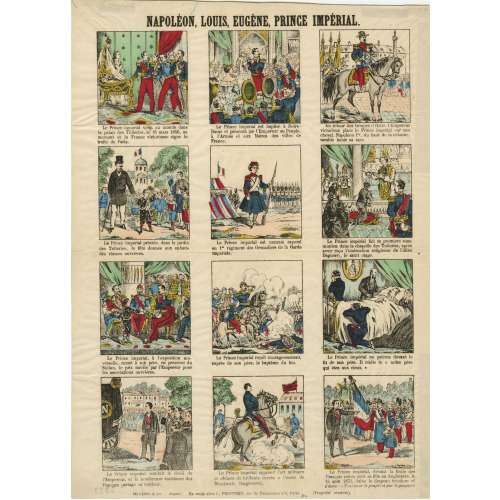 Another copy of SVFC-0745-3.2023, 395 x 290 mm; black ink stamp “5322” to reverse. Jean Charles Pellerin (French, 1756 – 1836)
Another copy of SVFC-0745-3.2023, 395 x 290 mm; black ink stamp “5322” to reverse. Jean Charles Pellerin (French, 1756 – 1836) -
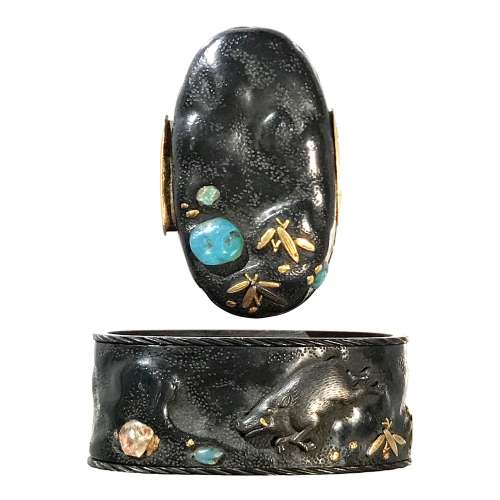 Signature: Unsigned
Signature: UnsignedFuchi-kashira with rock and boar (iwa ni inoshishi zu) motif. Inlay of precious stones or colour glass. Shakudō, gold, gemstones. Technique: Sukibori zogan kiniroe.
Fuchi: 36 x 21 x 14 mm; Weight: 22 g; Kashira: 32 x 17 x 5 mm; Weight: 8 g; Material : Shakudō; Gold; Gemstones (Chalcedony and Rose Quartz). Possibly, Owari school. -
 Artist: Utagawa Toyokuni I (1769–1825) Title: Actors Bando Mitsugorō, Ichikawa Danjūrō, Onoe Kikugorō in play The Maiden at Dōjō Temple. Presumably Bunka 13 (1816) at Nakamura Theater in Edo. Publisher: Mikawaya Seiemon (c. 1805-1829); Marks' "Publishers" № 328, p. 235. Size: Vertical ôban MEDIUM OR TECHNIQUE: Woodblock print (nishiki-e); ink and color on paper. Signed: Toyokuni ga Censor's seal: kiwame Detailed discussion on the topic can be seen at: The Maiden at Dōjō Temple
Artist: Utagawa Toyokuni I (1769–1825) Title: Actors Bando Mitsugorō, Ichikawa Danjūrō, Onoe Kikugorō in play The Maiden at Dōjō Temple. Presumably Bunka 13 (1816) at Nakamura Theater in Edo. Publisher: Mikawaya Seiemon (c. 1805-1829); Marks' "Publishers" № 328, p. 235. Size: Vertical ôban MEDIUM OR TECHNIQUE: Woodblock print (nishiki-e); ink and color on paper. Signed: Toyokuni ga Censor's seal: kiwame Detailed discussion on the topic can be seen at: The Maiden at Dōjō Temple -
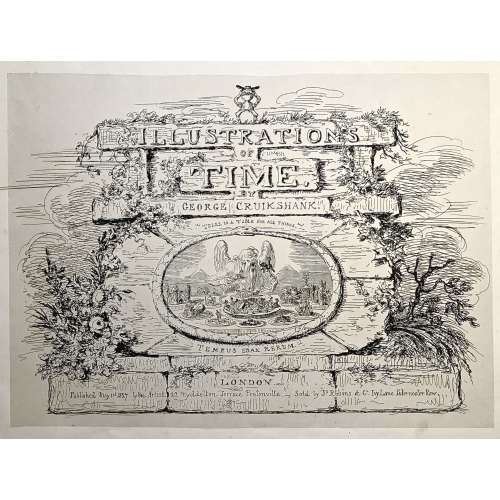
Engraved title page: ILLUSTRATION | OF | TIME. | GEORGE CRUIKSHANK. | "THERE IS A TIME FOR ALL THINGS". | TEMPUS EDAX RERUM. | LONDON | Published May 1st 1827 by the Artist - 22 Myddelton Terrace Pentonville. - Sold by Js. Robins & Co. Ivy Lane Paternoster Row.
Oblong folio, 33.5 x 44 cm. Engraved vignette title page and six not-coloured engraved plates with multiple images showing thirty-five humorous scenes.
First edition, first issue. Uncoloured. Pristine condition.
Half-leather bound in marbled cardboard and red morocco and gild lettering and arabesque. Frontispiece and 6 plates with protective tissues.
Content:1. Time-Called & Time-Come (five sketches)
2. Behind Time (seven sketches)
3. Time Thrown Away (six sketches)
4. Hard Times [&] Term Time (five sketches)
5. Time Badly Employed (five sketches)
6. Christmas Time (seven sketches)
British Museum № 1978,U.3026.1. BM description: "Frontispiece, the title on a background of symmetrical but dilapidated and grass-grown masonry. On the summit stands a little laughing gnome, with a wide hat and a body formed of an hour-glass; Inset is an oval bordered by a serpent with its tail in its mouth (emblem of eternity), in which is an aged and all-devouring Time (bald except for a forelock), seated behind a table whose surface is the base of the design. He puts to his mouth a fork on which is speared an elephant with a castle on its back containing tiny figures with spears. In his r. hand is a spoon containing a country church. His table is covered with dishes, and at his r. hand is a sickle. The central and biggest dish is heaped with a jumble of tiny objects: crown, table, chair, wheelbarrow, picture; round the room sit little figures: a soldier, parson, lady and child, &c. The ten other dishes contain: an antique glass coach with horses and footmen; an overladen camel beside a palm-tree; ruins of a castle; a farmhouse; a shepherd and sheep; a dismantled cannon and balls, cattle, a man-of-war in full sail; a ruinous Gothic cathedral; a clump of trees (the last two are dominated by a large decanter). Below Time are two (Egyptian) pyramids. Above: 'There Is A Time For All Things'; below: 'Tempus Edax Rerum'. 1 May 1827. Etching."Bibliography:- Reid, G W, A descriptive catalogue of the works of George Cruikshank, London, 1871.
- Stephens, Frederic George; George, Mary Dorothy, Catalogue of Political and Personal Satires in the Department of Prints and Drawings in the British Museum, 11 vols, London, BMP, 1870.
- Cohn, A M, George Cruikshank, catalogue raisonné, London, 1924.
-
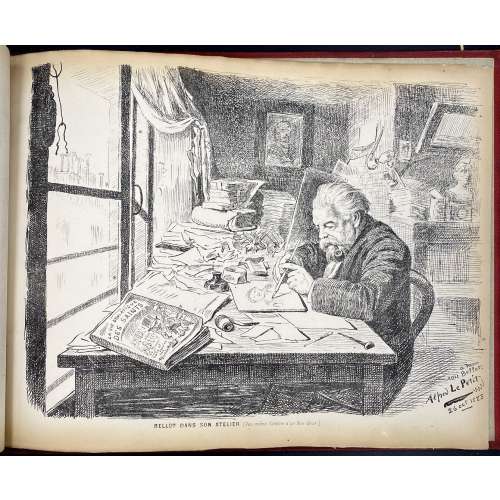 An album of the "Le Bon-Bock" dinners for the year 1884. Author, designer and publisher – Emile Bellot (French, 1831 – 1886), a Parisian artist and engraver. "Le Bon-Bock" was a monthly dinner of artists and men of letters, who gathered in Paris for good food, good company, and artistic performances, from 1875 to at least 1925. The story behind these gatherings as told by Emile Bellot, the founder, is this:
An album of the "Le Bon-Bock" dinners for the year 1884. Author, designer and publisher – Emile Bellot (French, 1831 – 1886), a Parisian artist and engraver. "Le Bon-Bock" was a monthly dinner of artists and men of letters, who gathered in Paris for good food, good company, and artistic performances, from 1875 to at least 1925. The story behind these gatherings as told by Emile Bellot, the founder, is this:In February 1875, Pierre Cottin1 came to me and said: 'I discovered a poet and tragedian of immense talent and who interprets the poems of the Great Victor Hugo in an astonishing way. Monsieur Gambini. I promised him that I would make it heard by an audience of artists and men of letters. I am counting on you who have many connections to keep my promise to him'. I gathered about 25 of my friends and acquaintances in a picnic dinner which took place at a restaurant 'Krauteimer' on the rue Rochechouart in Montmartre. They heard from Mr Gambini first, then my friends Étienne Carjat2, J. Gros3, Adrien Dézamy4, etc. performed. These gentlemen completed the evening so brilliantly that it was unanimously decided that we would start a similar dinner every month. Poets, musicians, men of letters, singers would be invited to this dinner. I was in charge of the organization of this little party and as it was the dream of my life to bring together old comrades, I was careful not to refuse and I pursued this good idea. Cottin and René Tener5 were kind enough to help me in this joyous task and especially my old friend Carjat. The following March began our 1st monthly dinner.
The name "Le Bon-Bock" means "The Good Bock", whilst Bock is a kind of beer, a dark, malty, lightly hopped ale. The dinner was named "Le Bon-Bock" in honour of the Éduard Manet painting (1873), a famous portrait of Emile Bellot, called "Le Bon-Bock".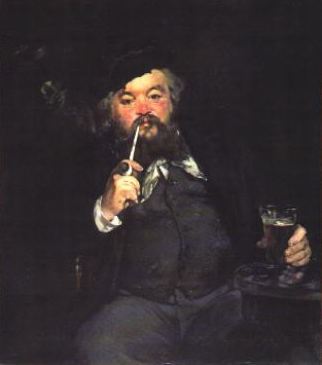 The invitations to the dinner were also produced by the artists and looked like this one by Alexandre Ferdinandus (October 3, 1883).
The invitations to the dinner were also produced by the artists and looked like this one by Alexandre Ferdinandus (October 3, 1883).
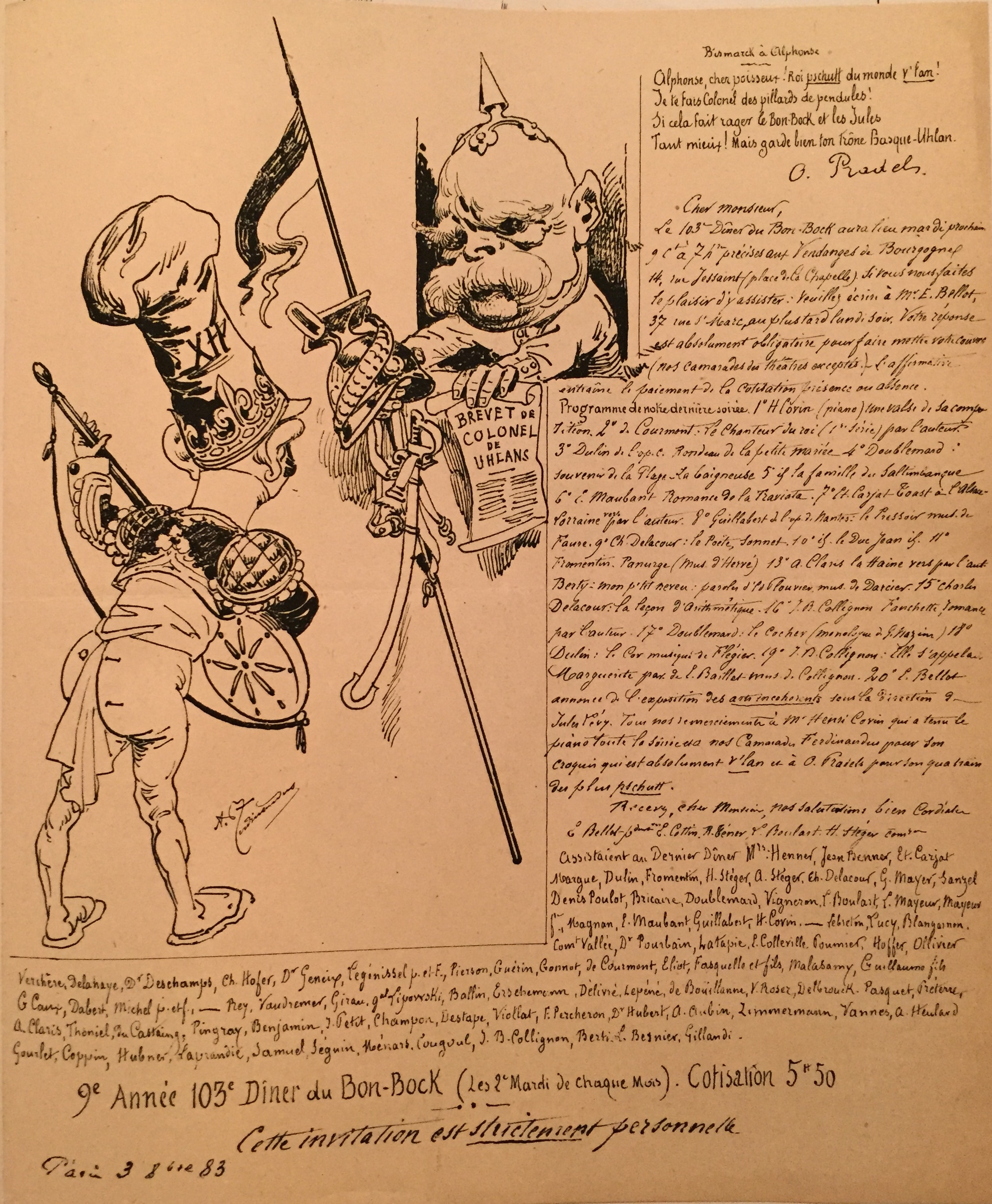 Besides this sketch of the Parisian social and artistic life at the end of the 19th century, the provenance of the album in our collection generates additional interest. The ink stamp to the front flyleaf reads: "Docteur Henry Uzan, 29 Avenue Perrichont, Paris XVI".
Doctor Henry Uzan was Jewish. He was arrested by the Pétain police on October 1, 1941, and interned in Drancy. With the few means at his disposal, he undertook to treat the sick whom he then saw leaving, week after week, towards their terrible destiny in the extermination camps. In October 1943 doctor Uzan was deported to the island of Alderney. After the Normandy Landing of June 6, 1944, Nazis evacuated the island detainees and transfer them to the Neuengamme camp, via northern France and Belgium. During the transfer, doctor Uzan managed to escape from the train on the night of September 3 to 4 around Dixmude in Flanders. He was taken in by the Belgian Resistance, which he joined before being repatriated to France.
In France, he continued working as a physician and was one of the founders of Association des internés et déportés politiques (AIDP). In 1945, together with his friends, the doctor designed the symbol for the Fédération nationale des déportés et internés résistants et patriotes:
Besides this sketch of the Parisian social and artistic life at the end of the 19th century, the provenance of the album in our collection generates additional interest. The ink stamp to the front flyleaf reads: "Docteur Henry Uzan, 29 Avenue Perrichont, Paris XVI".
Doctor Henry Uzan was Jewish. He was arrested by the Pétain police on October 1, 1941, and interned in Drancy. With the few means at his disposal, he undertook to treat the sick whom he then saw leaving, week after week, towards their terrible destiny in the extermination camps. In October 1943 doctor Uzan was deported to the island of Alderney. After the Normandy Landing of June 6, 1944, Nazis evacuated the island detainees and transfer them to the Neuengamme camp, via northern France and Belgium. During the transfer, doctor Uzan managed to escape from the train on the night of September 3 to 4 around Dixmude in Flanders. He was taken in by the Belgian Resistance, which he joined before being repatriated to France.
In France, he continued working as a physician and was one of the founders of Association des internés et déportés politiques (AIDP). In 1945, together with his friends, the doctor designed the symbol for the Fédération nationale des déportés et internés résistants et patriotes:
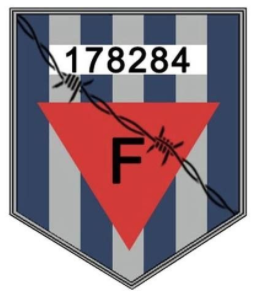 The story behind the number on the emblem (178284) is fascinating but it is out of the scope of this material.
The story behind the number on the emblem (178284) is fascinating but it is out of the scope of this material.
1. Pierre Cottin (French, 1823 – c. 1887) – Engraver, mezzotinter, genre and landscape painter; born in Chappelle-Saint-Denis (near Paris), a pupil of Jazet. Exhibited at the Salon from 1845, also in London from 1876 to 1879.↩ 2. Étienne Carjat (French, 1828 – 1906) – Journalist, caricaturist and photographer. ↩ 3. Jean Baptiste Louis Gros (French, 1793 – 1870) – Painter. ↩ 4. Adrien Dézamy (French, 1844 – 1891) – Writer, poet, general secretary of the Théâtre des Bouffes in Paris. ↩ 5. Rene Tener (French, 1846 – 1925) – Painter. ↩ Sources:Auguste Lepage. Les dîners artistiques et littéraires de Paris / Bibliothèque des Deux mondes (2e éd.) – Paris: Frinzine, Klein et Cie., 1884. [Accession № LIB-2606.2021 in this collection]
-
![Adelbert von Chamisso. Peter Schlemihl's wundersame Geschichte. Nach des Dichters Tode neu herausgegeben von Julius Eduard Hitzig. Stereotypausgabe mit Holzschnitten. — Nürnberg: Johann Leonhard Schrag, [o.J.], [1839]. — XVI + 83 S.](https://varshavskycollection.com/wp-content/uploads/2021/02/LIB-1100.2016-b-scaled-500x500.jpeg) Title page (in Gothic script): Peter Schlemihl's | wundersame Geschichte | mitgetheilt | von | Adelbert von Chamisso. | {vignette} | Nach des Dichters Tode neu herausgegeben | von Julius Eduard Hitzig. | Stereotypausgabe mit Holzschnitten. | Nürnberg, | Johann Leonhard Schrag. || Pagination: [i-iii] iv-xvi, [1] 2-82 [2], 15 woodcut vignettes by Unzelmann after Menzel. Collation: 8vo; π8 1-58 62. Binding: 21.5 x 13.5 cm, blind olive wrappers. Year of publication inferred from the foreword. This is the first posthumous edition of Chamisso's novel. Personae: Chamisso, Adelbert von (German, 1781 – 1838). — Author of the text. Hitzig, Julius Eduard [Itzig, Isaac Elias] (German-Jewish, 1780 – 1849). — Author of the foreword. Menzel, Adolph Friedrich Erdmann von (German, 1815 – 1905). — Artist of the vignettes. Unzelmann, Friedrich Ludwig (German, 1797 – 1854). — Engraver of the woodcuts. Schrag, Johann Leonhard (Germany, 1783 – 1858). — Publisher.
Title page (in Gothic script): Peter Schlemihl's | wundersame Geschichte | mitgetheilt | von | Adelbert von Chamisso. | {vignette} | Nach des Dichters Tode neu herausgegeben | von Julius Eduard Hitzig. | Stereotypausgabe mit Holzschnitten. | Nürnberg, | Johann Leonhard Schrag. || Pagination: [i-iii] iv-xvi, [1] 2-82 [2], 15 woodcut vignettes by Unzelmann after Menzel. Collation: 8vo; π8 1-58 62. Binding: 21.5 x 13.5 cm, blind olive wrappers. Year of publication inferred from the foreword. This is the first posthumous edition of Chamisso's novel. Personae: Chamisso, Adelbert von (German, 1781 – 1838). — Author of the text. Hitzig, Julius Eduard [Itzig, Isaac Elias] (German-Jewish, 1780 – 1849). — Author of the foreword. Menzel, Adolph Friedrich Erdmann von (German, 1815 – 1905). — Artist of the vignettes. Unzelmann, Friedrich Ludwig (German, 1797 – 1854). — Engraver of the woodcuts. Schrag, Johann Leonhard (Germany, 1783 – 1858). — Publisher. -
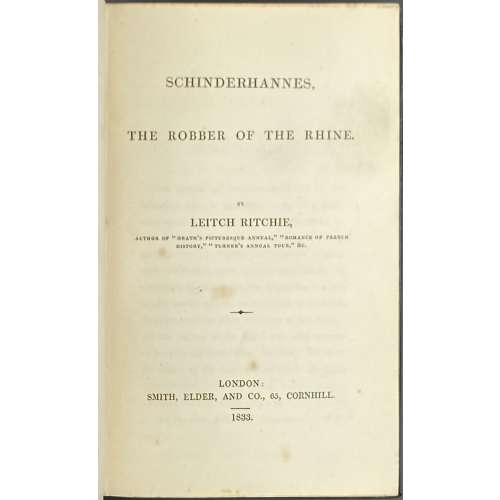 Serial title: THE | LIBRARY OF ROMANCE. | EDITED | BY LEITCH RITCHIE. | VOL. II. | — | SCHINDERHANNES, | THE ROBBER OF THE RHINE. | BY THE EDITOR. | — | LONDON: | SMITH, ELDER, AND CO., 65, CORNHILL. | — | 1833. || Title page: SCHINDERHANNES, | THE ROBBER OF THE RHINE. | BY | LEITCH RITCHIE, | AUTHOR OF “HEATH’S PICTURESQUE ANNUAL,” “ROMANCE OF FRENCH | HISTORY,” “TURNER’S ANNUAL TOUR,” &c. | — | LONDON: | SMITH, ELDER, AND CO., 65, CORNHILL. | — | 1833. || Pagination: [1] 2 – prospectus, [i, ii] – serial title / imprint, [iii-iv] – t.p. / blank, [v] vi (mispaged iv) – advert. [vii] viii – contents, [2] f.t. / blank; [1] 2-314 – text, [2] – advert. vol. I and III; total number of pages 12+314+2=328 Collation: 8vo; π6 B-U8 X4 Y2, total number of leaves 164. Binding: 18 x 11.5 cm, dark green buckram (faux morocco), gilt lettering and design elements to spine, printer’s imprint to π4: Bradbury and Evans, moiré endpapers. Cat. raisonné: Sadleir (v.2) 3760a, p. 171. Contributors: Leitch Ritchie (British-Scottish, 1800 – 1865) – author. Schinderhannes [Johannes Bückler] (German, c.1778 – 1803) – character. Bradbury & Evans (est.1830) – printer. Smith, Elder, and Company (1816 - 1917) – publisher. George Smith (British-Scottish, 1789 – 1846) – publisher. George Murray Smith (British, 1824 – 1901) – publisher. Alexander Elder (British, 1790 – 1876) – publisher.
Serial title: THE | LIBRARY OF ROMANCE. | EDITED | BY LEITCH RITCHIE. | VOL. II. | — | SCHINDERHANNES, | THE ROBBER OF THE RHINE. | BY THE EDITOR. | — | LONDON: | SMITH, ELDER, AND CO., 65, CORNHILL. | — | 1833. || Title page: SCHINDERHANNES, | THE ROBBER OF THE RHINE. | BY | LEITCH RITCHIE, | AUTHOR OF “HEATH’S PICTURESQUE ANNUAL,” “ROMANCE OF FRENCH | HISTORY,” “TURNER’S ANNUAL TOUR,” &c. | — | LONDON: | SMITH, ELDER, AND CO., 65, CORNHILL. | — | 1833. || Pagination: [1] 2 – prospectus, [i, ii] – serial title / imprint, [iii-iv] – t.p. / blank, [v] vi (mispaged iv) – advert. [vii] viii – contents, [2] f.t. / blank; [1] 2-314 – text, [2] – advert. vol. I and III; total number of pages 12+314+2=328 Collation: 8vo; π6 B-U8 X4 Y2, total number of leaves 164. Binding: 18 x 11.5 cm, dark green buckram (faux morocco), gilt lettering and design elements to spine, printer’s imprint to π4: Bradbury and Evans, moiré endpapers. Cat. raisonné: Sadleir (v.2) 3760a, p. 171. Contributors: Leitch Ritchie (British-Scottish, 1800 – 1865) – author. Schinderhannes [Johannes Bückler] (German, c.1778 – 1803) – character. Bradbury & Evans (est.1830) – printer. Smith, Elder, and Company (1816 - 1917) – publisher. George Smith (British-Scottish, 1789 – 1846) – publisher. George Murray Smith (British, 1824 – 1901) – publisher. Alexander Elder (British, 1790 – 1876) – publisher. -
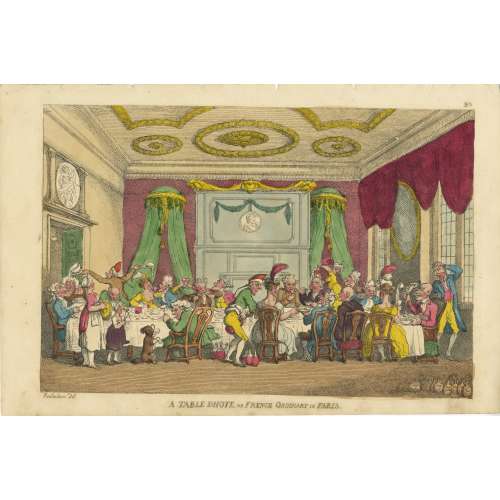 Hand-coloured etching by Thomas Rowlandson, printed on May 30, 1810, in London; № 20 from the series The Caricature Magazine or Hudibrastic Mirror Vol. 2. Description by Metropolitan Museum (59.533.978): "Guests of a dinner sit at a long narrow table in a magnificent room with an ornate ceiling. Two men and a young woman serve wine, one drawing a cork, the others spilling wine over the guests. Another waiter spills soup in an elderly guest's face. A woman and a little girl with a begging dog play tambourine and triangle at left." Inscribed in plate lower left: "Rowlandson Del."; bottom centre: "A TABLE DHOTE, OR FRENCH ORDINARY IN PARIS." Our copy is lacking the publication details: "Pub.d May 30. 1810 by Tho.s Tegg 111 Cheapside, London." and similar to the copy in Boston Public Library (18_03_000394). Dimensions: Sheet 27 x 40.5 cm; Image: 23.5 x 35 cm. Contributors: Thomas Rowlandson (British, 1756 – 1827) – artist. Thomas Tegg (British, 1776 – 1846) – publisher.
Hand-coloured etching by Thomas Rowlandson, printed on May 30, 1810, in London; № 20 from the series The Caricature Magazine or Hudibrastic Mirror Vol. 2. Description by Metropolitan Museum (59.533.978): "Guests of a dinner sit at a long narrow table in a magnificent room with an ornate ceiling. Two men and a young woman serve wine, one drawing a cork, the others spilling wine over the guests. Another waiter spills soup in an elderly guest's face. A woman and a little girl with a begging dog play tambourine and triangle at left." Inscribed in plate lower left: "Rowlandson Del."; bottom centre: "A TABLE DHOTE, OR FRENCH ORDINARY IN PARIS." Our copy is lacking the publication details: "Pub.d May 30. 1810 by Tho.s Tegg 111 Cheapside, London." and similar to the copy in Boston Public Library (18_03_000394). Dimensions: Sheet 27 x 40.5 cm; Image: 23.5 x 35 cm. Contributors: Thomas Rowlandson (British, 1756 – 1827) – artist. Thomas Tegg (British, 1776 – 1846) – publisher.




